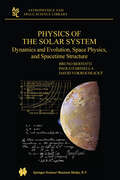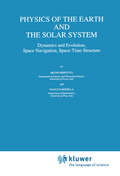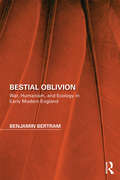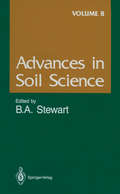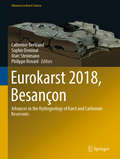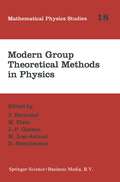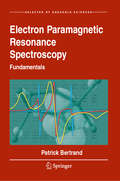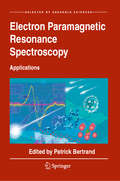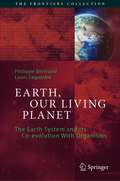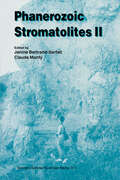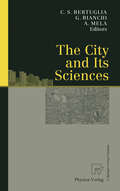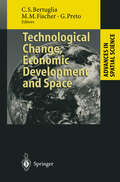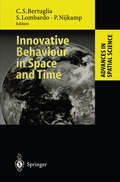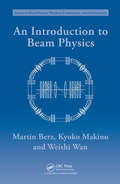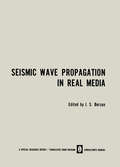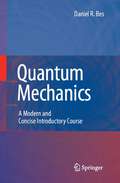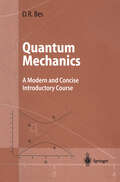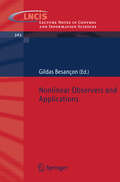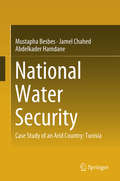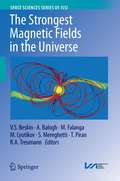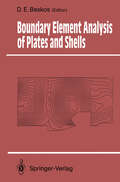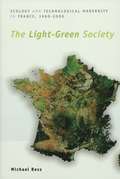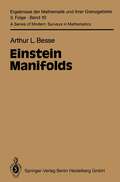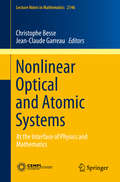- Table View
- List View
Physics of the Solar System: Dynamics and Evolution, Space Physics, and Spacetime Structure (Astrophysics and Space Science Library #293)
by B. Bertotti P. Farinella D. VokrouhlickyThis book is a direct sequel to: B. Bcrtotri and P. Farinclla, "Physics of the Earth and the Solar System, Dynamics and Evolution. Space Navigation. Spa cc-Time Structure" (Kluwcr Academic Publishers, 1990). Nearly 15 years af tcr its publication it became evident that the volume was in need of a new edition to keep up with the outstanding progress and the changing perspectives in this field. David Vokrouhlicky agreed to collaborate on the project and be the third author. On March 25, 2000. after a tong illness and a heart transplant. Paolo Farinella passed away. We then decided that. rather than aiming at a second edition, it made more sense to rewrite the book anew. While its basic content and the structure of the chapters are the same, important new topics have been added, including the extrasolar planetary systems, transneptunian objects. accurate determination of reference frames and new space projects. Greater relevance has been given to scmiquantitarive discussions before intro ducing formal developments: many figures have been added and updated and several errors corrected. More emphasis has given to the solar system, whereas geophysical topics have been left at a less advanced level. To mark this change the slightly differ ent title "Physics of the Solar System" was chosen. We wish to dedicate this book to the memory of Paolo Farinella. an out standing scientist, an invaluable collaborator and a dear friend.
Physics of the Earth and the Solar System: Dynamics and Evolution, Space Navigation, Space-Time Structure (Geophysics and Astrophysics Monographs #31)
by B. Bertotti Paolo FarinellaFrom the reviews: ".....The book is a very good balance between theory and applications, of analysis and synthesis, keeping always the focus on the comprehension of the physics ruling our planetary system. In summary, this represents both an excellent textbook for students and a fundamental reference, and encyclopedic summary current knowledge, for researchers in the Solar System field." (Alessandro Rossi, Celestial Mechanics and Dynamical Astronomy, 2005)
Bestial Oblivion: War, Humanism, and Ecology in Early Modern England (Perspectives on the Non-Human in Literature and Culture)
by Benjamin BertramAlthough war is a heterogeneous assemblage of the human and nonhuman, it nevertheless builds the illusion of human autonomy and singularity. Focusing on war and ecology, a neglected topic in early modern ecocriticism, Bestial Oblivion: War, Humanism, and Ecology in Early Modern England shows how warfare unsettles ideas of the human, yet ultimately contributes to, and is then perpetuated by, anthropocentrism. Bertram’s study of early modern warfare’s impact on human-animal and human-technology relationships draws upon posthumanist theory, animal studies, and the new materialisms, focusing on responses to the Anglo-Spanish War, the Italian Wars, the Wars of Religion, the colonization of Ireland, and Jacobean “peace.” The monograph examines a wide range of texts—essays, drama, military treatises, paintings, poetry, engravings, war reports, travel narratives—and authors—Erasmus, Machiavelli, Digges, Shakespeare, Marlowe, Coryate, Bacon—to show how an intricate web of perpetual war altered the perception of the physical environment as well as the ideologies and practices establishing what it meant to be human.
Bestial Oblivion: War, Humanism, and Ecology in Early Modern England (Perspectives on the Non-Human in Literature and Culture)
by Benjamin BertramAlthough war is a heterogeneous assemblage of the human and nonhuman, it nevertheless builds the illusion of human autonomy and singularity. Focusing on war and ecology, a neglected topic in early modern ecocriticism, Bestial Oblivion: War, Humanism, and Ecology in Early Modern England shows how warfare unsettles ideas of the human, yet ultimately contributes to, and is then perpetuated by, anthropocentrism. Bertram’s study of early modern warfare’s impact on human-animal and human-technology relationships draws upon posthumanist theory, animal studies, and the new materialisms, focusing on responses to the Anglo-Spanish War, the Italian Wars, the Wars of Religion, the colonization of Ireland, and Jacobean “peace.” The monograph examines a wide range of texts—essays, drama, military treatises, paintings, poetry, engravings, war reports, travel narratives—and authors—Erasmus, Machiavelli, Digges, Shakespeare, Marlowe, Coryate, Bacon—to show how an intricate web of perpetual war altered the perception of the physical environment as well as the ideologies and practices establishing what it meant to be human.
Advances in Soil Science (Advances in Soil Science #8)
by A. R. Bertrand J. C. Day R. J. Gibbs P. M. Huang R. E. Meyer A.S.P. Murthy R. I. Papendick J. B. Reid J. L. SteinerAdvances in Soil Science is a review series relevant to all areas of soil science. These reviews, intended primarily for scientists, teachers, and students of soil science, also provide technical background information for many additional workers and groups interested in our natural resources and man's influence on them. This is the eighth volume in the series with an international list of contributors from the United States, India, Canada and New Zealand. It contains four review chapters on the following subjects: factors affecting aluminum transformations in soil; soil productivity in dryland regions of developing countries; changes in soil structure under different cropping systems; properties and management of the depleted soils of India. These contributions present valuable information on a diversity of topics and serve as an excellent source of references.
Eurokarst 2018, Besançon: Advances in the Hydrogeology of Karst and Carbonate Reservoirs (Advances in Karst Science)
by Catherine Bertrand Sophie Denimal Marc Steinmann Philippe RenardThis book presents selected papers from the EuroKarst 2018 conference, which highlighted the latest advances in the field of Karst Hydrogeology and Carbonate Reservoirs. The event attracted more than 180 participants. From among their contributions, the papers were selected and subsequently reviewed by the scientific committee to ensure the highest possible quality.
Modern Group Theoretical Methods in Physics: Proceedings of the Conference in Honour of Guy Rideau (Mathematical Physics Studies #18)
by J. Bertrand M. Flato J. P. Gazeau M. Irac-Astaud Daniel SternheimerThis book contains the proceedings of a meeting that brought together friends and colleagues of Guy Rideau at the Université Denis Diderot (Paris, France) in January 1995. It contains original results as well as review papers covering important domains of mathematical physics, such as modern statistical mechanics, field theory, and quantum groups. The emphasis is on geometrical approaches. Several papers are devoted to the study of symmetry groups, including applications to nonlinear differential equations, and deformation of structures, in particular deformation-quantization and quantum groups. The richness of the field of mathematical physics is demonstrated with topics ranging from pure mathematics to up-to-date applications such as imaging and neuronal models. Audience: Researchers in mathematical physics.
Electron Paramagnetic Resonance Spectroscopy: Fundamentals
by Patrick BertrandAlthough originally invented and employed by physicists, electron paramagnetic resonance (EPR) spectroscopy has proven to be a very efficient technique for studying a wide range of phenomena in many fields, such as chemistry, biochemistry, geology, archaeology, medicine, biotechnology, and environmental sciences. Acknowledging that not all studies require the same level of understanding of this technique, this book thus provides a practical treatise clearly oriented toward applications, which should be useful to students and researchers of various levels and disciplines. In this book, the principles of continuous wave EPR spectroscopy are progressively, but rigorously, introduced, with emphasis on interpretation of the collected spectra. Each chapter is followed by a section highlighting important points for applications, together with exercises solved at the end of the book. A glossary defines the main terms used in the book, and particular topics, whose knowledge is not required for understanding the main text, are developed in appendices for more inquisitive readers.
Electron Paramagnetic Resonance Spectroscopy: Applications
by Patrick BertrandThis book shows how the fundamentals of electron paramagnetic resonance (EPR) spectroscopy are practically implemented and illustrates the diversity of current applications. The technique is used at various levels, and applications are presented in order of increasing difficulty, with reference to theoretically obtained results. This book features a diverse array of application examples, from fields such as ionizing radiation dosimetry, neurodegenerative diseases, structural transitions in proteins, and the origins of terrestrial life. The final chapter of this book highlights the principles and applications of the technique of ferromagnetic resonance spectroscopy, followed by a brief introduction to advanced EPR techniques such as electron spin echo envelope modulation (ESEEM), hyperfine sub-level correlation (HYSCORE), pulsed electron-electron double resonance (PELDOR), and continuous wave electron nuclear double resonance (ENDOR) experiments.
Earth, Our Living Planet: The Earth System and its Co-evolution With Organisms (The Frontiers Collection)
by Philippe Bertrand Louis LegendreEarth is, to our knowledge, the only life-bearing body in the Solar System. This extraordinary characteristic dates back almost 4 billion years. How to explain that Earth is teeming with organisms and that this has lasted for so long? What makes Earth different from its sister planets Mars and Venus? The habitability of a planet is its capacity to allow the emergence of organisms. What astronomical and geological conditions concurred to make Earth habitable 4 billion years ago, and how has it remained habitable since? What have been the respective roles of non-biological and biological characteristics in maintaining the habitability of Earth? This unique book answers the above questions by considering the roles of organisms and ecosystems in the Earth System, which is made of the non-living and living components of the planet. Organisms have progressively occupied all the habitats of the planet, diversifying into countless life forms and developing enormous biomasses over the past 3.6 billion years. In this way, organisms and ecosystems "took over" the Earth System, and thus became major agents in its regulation and global evolution. There was co-evolution of the different components of the Earth System, leading to a number of feedback mechanisms that regulated long-term Earth conditions. For millennia, and especially since the Industrial Revolution nearly 300 years ago, humans have gradually transformed the Earth System. Technological developments combined with the large increase in human population have led, in recent decades, to major changes in the Earth's climate, soils, biodiversity and quality of air and water. After some successes in the 20th century at preventing internationally environmental disasters, human societies are now facing major challenges arising from climate change. Some of these challenges are short-term and others concern the thousand-year evolution of the Earth's climate. Humans should become the stewards of Earth.
Phanerozoic Stromatolites II
by Janine Bertrand-Sarfati C. MontyPrecambrian stromatolites have received in depth, consideration from geologists and paleontologists; they were indeed searching for biosedimentary structures that were sufficiently characteristic and widely distributed to be considered as useful tools for stratigraphic correlation. Silicified stromatolites are also of interest as they contain preserved traces of ancient life. Calcareous Phanerozoic stromatolites have not received very much attention from geologists. Logan's too schematic morphological classification of 1964, was not so helpful to the knowledge of Phanerozoic stromatolites because neither their morphology nor their microstructure were studied in the same detail in which Proterozoic stromatolites have now been described. We therefore know little about the Phanerozoic stromatolites which, do, however, show an interesting range of diversification. A major questions stiII remaining to be answered include the history of stromatolite development and wether their morphology has "evolved" in addition to detailed information concerning Cenozoic nonmarine stromatolites which precipitate carbonate and the Recent giant stromatolites which trap particles. For these reasons Claude Monty, in 1981, launched the first volume of what was going to be a series on "Phanerozoic stromatolites" in order to describe their morphology, microstructure and paleoecology and to present them in their stratigraphic context.
The City and Its Sciences
by Cristoforo S. Bertuglia Giuliano Bianchi Alfredo MelaRecent developments in the field of urban analysis and management are investigated in this book. It is a wide-ranging collection of essays on the subject drawn from a long-term project and seminar, held in Italy, to review the state of the art and speculate on the future influence on the "sciences of the city" of the complexity concept. Of particular interest is the variety of points of view, often contrasting, and the attempt to go beyond the conventional approaches to the analysis, and the planning of the city. While focussing mainly on the European (and in particular Italian) context, the discussion is of general relevance and valuable to anyone concerned with the prospects for the city in the new millenium.
Technological Change, Economic Development and Space (Advances in Spatial Science)
by Cristoforo S. Bertuglia Manfred M. Fischer Giorgio PretoThe pressures of global competition are affecting regions throughout the world and making it increasingly necessary to understand the complex underlying mechanisms and the potential for innovation offered by new technology. Success in economic restructuring depends not only on the technology itself, but the professional and entrepreneurial skills available and the support of provided by institutions and information networks. The very local nature these phenomena, which are critical to the innovative propensity of firms operating within the region, introduces an inevitable spatial dimension. The time therefore seems ripe to bring together contributions from scholars working in different, but related disciplines, with the aim of investigating the triangular relationship between technological change, economic development and space. The present volume offers a compact review of current theoretical developments and valuable insights deriving from recent empirical studies carried out both within Europe and elsewhere. All those contributing to this volume are actively involved in research in the field. Without their intellectual contribution and willingness to participate in this joint project, the book would not have been possible. We should like, in addition, to thank Angela Spence for her capable assistance in coordinating the various stages of preparation of the book, as well as her translation work and careful linguistic editing. Thanks also go to Paola Stasi for her meticulous copy editing and help in preparing the indices. Their work has been invaluable in moulding together in a single volume contributions from so many different sources.
Innovative Behaviour in Space and Time (Advances in Spatial Science)
by Cristoforo S. Bertuglia Silvana Lombardo Peter NijkampIn the past decade there has been growing recognition that economic development is not mainly exogenously determined but, to a large extent, is a transformation process induced and governed by economic actors who respond to competitive, institutional and political challenge. This 'challenge and response' model is increasingly accepted as a valid analytical framework in modem growth theory and also explains the popularity of endogenous growth approaches to technological innovation issues. However, a major and as yet largely under-researched topic is the question of the diffusion and adoption of new technological changes in the context of space-time dynamics. This diffusion and adoption pattern has obviously clear spatial and temporal variations connected with behavioural responses which may vary over time and different locations. This means that a closer analysis of spatio-temporal opportunities and impediments is necessary in order to fully map the complex interactions of technology and economy in space and time. This volume sets out to bring together a collection of original contributions commissioned by the editors to highlight the spatio-temporal patterns and backgrounds of the diffusion and adoption of new technologies. Some are in the nature of a survey, others.have a modelling background and again others are case studies. The contributions originate from different countries and different disciplines. This book is complementary to a previously published volume on technological innovation, Technological Change, Economic Development and Space, edited by C.S. Bertuglia, M.M. Fischer and G. Preto, and also published by Springer-Verlag (1995).
An Introduction to Beam Physics
by Martin Berz Kyoko Makino Weishi WanThe field of beam physics touches many areas of physics, engineering, and the sciences. In general terms, beams describe ensembles of particles with initial conditions similar enough to be treated together as a group so that the motion is a weakly nonlinear perturbation of a chosen reference particle. Particle beams are used in a variety of areas,
Seismic Wave Propagation in Real Media: Modeli Real’nykh Sred I Seismicheskie Volnovye Polya / Модели Реальных Сред И Сейсмические Волновые Поля
by S. BerzonUntil recently, the interpretation of data obtained in seismic exploration has been based on comparatively simple representations of the Earth. The most commonly used representation for the Earthhas been a set of thick layers, each characterized by a single value for the propa gation speed of seismic waves. During the last several years, more complicated representa tions in the form of thin layers with vertical velocity gradients, as weIl as homogeneous thin layers have been considered. New methods for studying propagation speeds in a medium, particularly ultrasonic logging methods, and the results of theoretical and experimental studies of the dynamic characteristics of seismic waves have revealed that areal Earth is considerably more complicated than the simple models accepted in the past. This has led to a need for more realistic representations of the real Earth as a medium through wh ich seismic waves propagate. Because of this, tlie Department of Seismic Exploration Methods of the Institute of Physics of the Earth of the Acad emy of Sciences of the USSR has been carrying out both experimental and theoretical studies on the topic "Selection of Physical Representations of Actual Media and the Study of the Correspond ing Wave Propagation Effects. " Three major subdivisions have been recognized within this over all pro gram: 1. The establishment of a direct relationship between the structure of a real medium and the basic wave-propagation characteristics.
Quantum Mechanics: A Modern and Concise Introductory Course
by Daniel BesStarting from basic principles, the book systematically covers both Heisenberg and Schrödinger realizations of quantum mechanics (in this order). It provides excellent didactic introduction to the essential principles and treats recent concepts such as entanglement and decoherence. The book gives the background needed to understand quantum cryptography, teleportation and computation, and it is especially suitable for introducing the spin. This second edition includes a more friendly presentation to Hilbert spaces, and more practical applications e.g. scanning tunneling microscope (potential barrier).
Quantum Mechanics: A Modern and Concise Introductory Course (Advanced Texts in Physics)
by Daniel BesStarting from basic principles, the book systematically covers both Heisenberg and Schrödinger realizations of quantum mechanics (in this order). It provides excellent didactic introduction to the essential principles and treats recent concepts such as entanglement and decoherence. The book gives the background needed to understand quantum cryptography, teleportation and computation, and it is especially suitable for introducing the spin. This second edition includes a more friendly presentation to Hilbert spaces, and more practical applications e.g. scanning tunneling microscope (potential barrier).
Nonlinear Observers and Applications (Lecture Notes in Control and Information Sciences #363)
by Gildas BesançonThe purpose of this fantastically useful book is to lay out an overview on possible tools for state reconstruction in nonlinear systems. Here, basic observability notions and observer structures are recalled, together with ingredients for advanced designs on this basis. The problem of state reconstruction in dynamical systems, known as observer problem, is crucial for controlling or even merely monitoring processes. For linear systems, the theory has been well established for several years, so this book attempts to tackle the problem for non-linear systems.
National Water Security: Case Study of an Arid Country: Tunisia
by Mustapha Besbes Jamel Chahed Abdelkader HamdaneThis book shows how the change of water paradigm has become urgent, and provides evidence for new policies that expand water balance to green and virtual water. The issue of water security concerns drinking water supply but also food safety, linked to agricultural policy. Both rain-fed and irrigated agriculture play complementary roles in food security, and the water issue implies a holistic view of water resources. This view constitutes the book's backstory. The reader will find original ideas that can be applied everywhere because the example of Tunisia is typically a basis to illustrate a universally prevalent situation. The book deals with other important issues: desalination, wastewater recycling, water quality, groundwater overdraft, water savings, governance, knowledge valuing, education, information: upgrading the whole water systems for the future implies emancipation of the whole society.
The Strongest Magnetic Fields in the Universe (Space Sciences Series of ISSI #54)
by V. S. Beskin A. Balogh M. Falanga M. Lyutikov S. Mereghetti T. Piran R. A. TreumannThis volume extends the ISSI series on magnetic fields in the Universe into the domain of what are by far the strongest fields in the Universe, and stronger than any field that could be produced on Earth. The chapters describe the magnetic fields in non-degenerate strongly magnetized stars, in degenerate stars (such as white dwarfs and neutron stars), exotic members called magnetars, and in their environments, as well as magnetic fields in the environments of black holes. These strong fields have a profound effect on the behavior of matter, visible in particular in highly variable processes like radiation in all known wavelengths, including Gamma-Ray bursts. The generation and structure of such strong magnetic fields and effects on the environment are also described.
Boundary Element Analysis of Plates and Shells (Springer Series in Computational Mechanics)
by Dimitri E. BeskosThe Light-Green Society: Ecology and Technological Modernity in France, 1960-2000
by Michael BessThe accelerating interpenetration of nature and culture is the hallmark of the new "light-green" social order that has emerged in postwar France, argues Michael Bess in this penetrating new history. On one hand, a preoccupation with natural qualities and equilibrium has increasingly infused France's economic and cultural life. On the other, human activities have laid an ever more potent and pervasive touch on the environment, whether through the intrusion of agriculture, industry, and urban growth, or through the much subtler and more well-intentioned efforts of ecological management. The Light-Green Society limns sharply these trends over the last fifty years. The rise of environmentalism in the 1960s stemmed from a fervent desire to "save" wild nature-nature conceived as a qualitatively distinct domain, wholly separate from human designs and endeavors. And yet, Bess shows, after forty years of environmentalist agitation, much of it remarkably successful in achieving its aims, the old conception of nature as a "separate sphere" has become largely untenable. In the light-green society, where ecology and technological modernity continually flow together, a new hybrid vision of intermingled nature-culture has increasingly taken its place.
Einstein Manifolds (Classics In Mathematics Ser.)
by Arthur L. BesseEinstein's equations stem from General Relativity. In the context of Riemannian manifolds, an independent mathematical theory has developed around them. This is the first book which presents an overview of several striking results ensuing from the examination of Einstein’s equations in the context of Riemannian manifolds. Parts of the text can be used as an introduction to modern Riemannian geometry through topics like homogeneous spaces, submersions, or Riemannian functionals.
Nonlinear Optical and Atomic Systems: At the Interface of Physics and Mathematics (Lecture Notes in Mathematics #2146)
by Christophe Besse Jean-Claude GarreauFocusing on the interface between mathematics and physics, this book offers an introduction to the physics, the mathematics, and the numerical simulation of nonlinear systems in optics and atomic physics. The text covers a wide spectrum of current research on the subject, which is an extremely active field in physics and mathematical physics, with a very broad range of implications, both for fundamental science and technological applications: light propagation in microstructured optical fibers, Bose-Einstein condensates, disordered systems, and the newly emerging field of nonlinear quantum mechanics. Accessible to PhD students, this book will also be of interest to post-doctoral researchers and seasoned academics.
